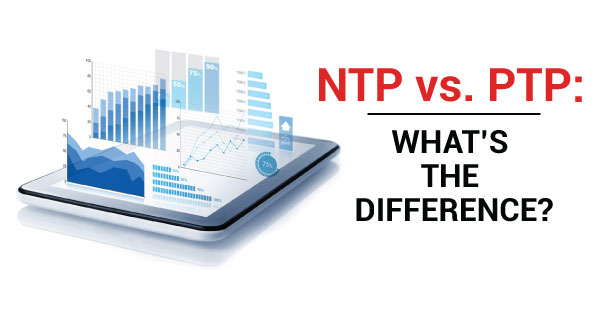NTP vs. PTP: What’s The Difference?

Time synchronization is critical within any network to operate efficiently and effectively for your business. If devices are not synchronized within your network, complications can arise. While using a public internet time server is one option that can be considered, there are caveats to using an external time source including security concerns and network latency issues. The most secure method for network time synchronization is through the use of a local GPS time server as your master network clock. A GPS network time server provides you a Stratum 1 time source within your internal network that will be reliable, and unlike a public time server, is not impacted if the internet goes down. If you decide to use a GPS time server for your network time synchronization, you have choices to make: should you use an NTP time server or a PTP time server, and what’s the real difference?
Both NTP and PTP time servers use network time protocols to serve time to other devices on the network and achieve time synchronization. Below we will discuss the basic differences between NTP and PTP time servers to help you make decisions on the best choice for your business needs, and ultimately it comes down to the accuracy you need.
NTP Servers
Network Time Protocol, or NTP, is one of the oldest Internet protocols still in use today. An NTP server is directly connected to a highly accurate timekeeping source, like the GPS satellite network that orbits the Earth. The server receives time information from the GPS satellites, uses algorithms to process the information, and then broadcasts it to all devices on the network that are requesting time information. NTP servers like our TM1000A can synchronize clocks and other local network devices with nearly millisecond accuracy, which suits most business and industrial needs for time serving accuracy. However, if greater than millisecond synchronization accuracy is required, a PTP server might be the best bet.
PTP Servers
Precision Time Protocol, or PTP, was originally defined and standardized by the IEEE in 2002. As with NTP, PTP may also utilize the GPS satellite network as its highly accurate time source, and also uses algorithms to process the time information it receives. However, PTP time servers have additional processors and use both hardware and software to broadcast the time and network status information to its clients on the network. With the addition of network latency information and hardware timestamping, PTP devices can achieve microsecond accuracy or better. If you need the highest possible degree of accuracy in your network time server, a PTP device like our TM2000A will likely work best for you.
If time synchronization is important to you, TimeMachines can provide solutions for your larger network and the clocks within it to create a complete synchronized clock system. TimeMachines carries both NTP and PTP GPS time servers, which can provide you with an inexpensive, reliable, and secure Stratum 1 time source that can serve accurate time to your entire network. To make sure you’re getting the right time server for your company and for more information on whether NTP or PTP is right for you, contact TimeMachines today.
